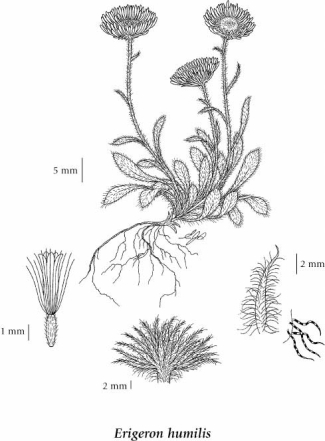Erigeron humilis Graham
arctic-alpine daisy (arctic alpine fleabane)
Asteraceae (Aster family)
Introduction to Vascular Plants
arctic-alpine daisy (arctic alpine fleabane)
Asteraceae (Aster family)
Introduction to Vascular Plants
Species Information
General:
Perennial herb from a short taproot or a short, brittle, woody stem-base and often some fibrous roots; stems generally lax, erect or ascending, more or less spreading long-hairy, the hairs, especially the upper ones, usually with some purple cross-walls, 1-25 cm tall.
Leaves:
Basal leaves oblanceolate or occasionally spoon-shaped, 1-9 cm long, 1.5-11 mm wide; stem leaves reduced upwards, linear or linear-lanceolate, the lowermost abruptly sharp-pointed, the uppermost tapering to a slender tip.
Flowers:
Heads with ray and disk flowers, solitary, the disks 10-20 mm wide; involucres 6-9 mm wide; involucral bracts subequal, more or less densely long woolly-hairy, the hairs with dark purple or blackish cross-walls (rarely without or with only a few purplish crosswalls) narrow, loose, tapering to a slender tip, generally heavily tinted blackish-purple, rarely more greenish; ray flowers 50-150, white to purplish, 3.5-6 mm long, 0.5-1 mm wide; disk flowers 2.4-4.8 mm long.
Fruits:
Achenes 2-nerved, more or less hairy; pappus double, the inner of about 20-30 bristles, these exceeding the disk flowers, the outer of a few short and inconspicuous scales.
Notes:
Some specimens (in or near populations of normal plants) from northern BC and YT have whitish involucral hairs that lack or have only a few purplish crosswalls (Douglas 1995). These plants are extremely difficult to separate from Erigeron uniflorus ssp. eriocephalus with which they may be hybridizing.
Illustration

If more than one illustration is available for a species (e.g., separate illustrations were provided for two subspecies) then links to the separate images will be provided below. Note that individual subspecies or varietal illustrations are not always available.
Illustration Source: The Illustrated Flora of British Columbia
Ecology
Ecological Framework for Erigeron humilis
The table below shows the species-specific information calculated from
original data (BEC database) provided by the BC Ministry of Forests and Range.
(Updated August, 2013)
The table below shows the species-specific information calculated from
original data (BEC database) provided by the BC Ministry of Forests and Range.
(Updated August, 2013)
| Site Information |
Value / Class |
||
|
Avg |
Min |
Max |
|
| Elevation
(metres) |
1775 | 475 | 2550 |
| Slope
Gradient (%) |
23 | 0 | 85 |
|
Aspect (degrees) |
162 | 2 | 355 |
| Soil
Moisture Regime (SMR) [0 - very xeric; 4 - mesic; 8 - hydric] |
3 | 0 | 8 |
| Modal
Nutrient Regime
Class |
C | ||
| #
of field plots species was recorded in: |
148 | ||
| Modal
BEC Zone Class |
BAFA | ||
|
All BEC Zones (# of stations/zone) species was recorded in |
AT(10), BAFA(59), BWBS(1), cma(1), ESSF(41), IMA(5), MH(2), SBS(5), SWB(11) | ||
|
Source:
Klinkenberg 2013
|
|||
Habitat and Range
Wet to moist seepage areas and meadows in the montane to alpine zones; common throughout N BC, rare in S BC; N to AK, YT and NT, E to PQ and S to MT and N WA.Status Information
Synonyms
Synonyms and Alternate Names:
Erigeron uniflorus var. unalaschkensis (DC.) Ostenf.
Erigeron unalaschkensis (DC.) Vierh.